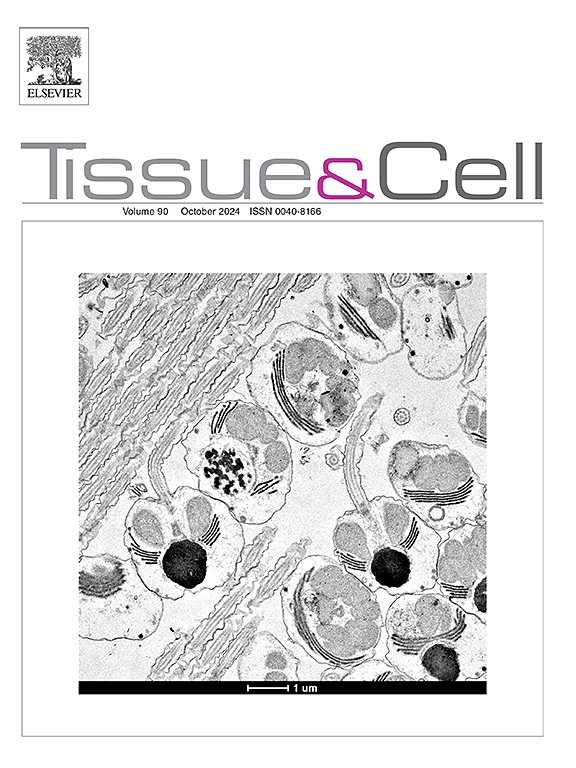Mitochondria transfer from mesenchymal stem cells into osteoarthritic chondrocytes ameliorate cellular functions and alleviate both inflammation and oxidative stress
IF 2.7
4区 生物学
Q1 ANATOMY & MORPHOLOGY
引用次数: 0
Abstract
Objective
Osteoarthritis, a common age-related joint disease, causes cartilage degeneration, leading to pain and disability. While pain management exists, cartilage regeneration options are limited. Exogenous mitochondria transfer is a novel regenerative approach. This study aimed to investigate the effects of exogenous mitochondrial transfer on cellular function, oxidative stress, inflammation, and apoptosis in osteoarthritic chondrocytes.
Methods
Two inflammatory models using M1-macrophage conditioned medium or co-culture with synovial fluid mesenchymal stem cells (MSCs) were established. The study compared mitochondria from Wharton's jelly (WJ-) and bone marrow (BM-) MSCs by analyzing their transfer to these models. Transfer effects were evaluated by mitochondrial membrane potential, cell viability, apoptosis, gene expression, and oxidative state.
Results
Mitochondria tracking showed high transfer efficiencies (99.62 % for WJ-MSCs, 91.34 % for BM-MSCs). Late apoptosis was significantly reduced after transfer of WJ-MSCs mitochondria from 5.58 % to 2.93 % in the model with M1-macrophage conditioned medium. Expression of TNF-α and IL-1β was reduced after mitochondrial delivery. The expression of Ki67 was induced in parallel with increased ATP production and reduced HMOX-1 expression levels after the transfer. A decrease of 2.5- and 5-fold in ATP levels in cells after the inflammatory models were recovered after WJ-MSCs mitochondria transfer by 3.1- and 100-fold depending on the inflammatory model used. Although ROS levels remained unchanged, MDA levels decreased, and collagen type-2 expression increased.
Conclusion
Mitochondria transfer improved key aspects of chondrocyte dysfunction in inflammatory osteoarthritis models. These findings support its therapeutic potential for treating or slowing osteoarthritis by directly improving damaged chondrocyte health and function.
线粒体从间充质干细胞转移到骨关节炎软骨细胞改善细胞功能,减轻炎症和氧化应激
目的骨关节炎是一种常见的与年龄相关的关节疾病,它会导致软骨变性,导致疼痛和残疾。虽然存在疼痛管理,但软骨再生的选择有限。外源线粒体转移是一种新的再生途径。本研究旨在探讨外源性线粒体转移对骨关节炎软骨细胞功能、氧化应激、炎症和凋亡的影响。方法采用m1 -巨噬细胞条件培养基和与滑膜液间充质干细胞(MSCs)共培养两种炎症模型。该研究比较了沃顿水母(WJ-)和骨髓(BM-)间质干细胞的线粒体,分析了它们向这些模型的转移。通过线粒体膜电位、细胞活力、凋亡、基因表达和氧化状态评估转移效果。结果线粒体追踪效率高(WJ-MSCs为99.62 %,BM-MSCs为91.34 %)。在m1 -巨噬细胞条件培养基中,WJ-MSCs线粒体转移后,细胞晚期凋亡从5.58 %显著减少至2.93 %。线粒体输送后TNF-α和IL-1β表达降低。转染后,Ki67的表达与ATP的增加和HMOX-1表达水平的降低同时被诱导。在WJ-MSCs线粒体转移后,炎症模型后细胞中ATP水平下降了2.5倍和5倍,根据所使用的炎症模型,ATP水平下降了3.1倍和100倍。虽然ROS水平保持不变,但MDA水平下降,2型胶原表达增加。结论线粒体转移改善了炎性骨关节炎模型软骨细胞功能障碍的关键方面。这些发现支持其通过直接改善受损软骨细胞的健康和功能来治疗或减缓骨关节炎的治疗潜力。
本文章由计算机程序翻译,如有差异,请以英文原文为准。
求助全文
约1分钟内获得全文
求助全文
来源期刊

Tissue & cell
医学-解剖学与形态学
CiteScore
3.90
自引率
0.00%
发文量
234
期刊介绍:
Tissue and Cell is devoted to original research on the organization of cells, subcellular and extracellular components at all levels, including the grouping and interrelations of cells in tissues and organs. The journal encourages submission of ultrastructural studies that provide novel insights into structure, function and physiology of cells and tissues, in health and disease. Bioengineering and stem cells studies focused on the description of morphological and/or histological data are also welcomed.
Studies investigating the effect of compounds and/or substances on structure of cells and tissues are generally outside the scope of this journal. For consideration, studies should contain a clear rationale on the use of (a) given substance(s), have a compelling morphological and structural focus and present novel incremental findings from previous literature.
 求助内容:
求助内容: 应助结果提醒方式:
应助结果提醒方式:


